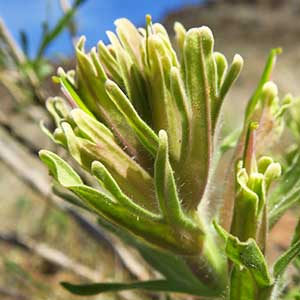Castilleja xanthotricha
Castilleja revealii
John Day or yellow-hairy paintbrush, John Day paintbrush, yellow hair paintbrush, yellow-hair Indian paintbrush
Bryce Canyon Indian paintbrush, Reveal's paintbrush
few to several, ± decumbent to erect or ascending, unbranched, sometimes with short, leafy axillary shoots, hairs erect to spreading, long, soft, eglandular, mixed with short stipitate-glandular ones.
solitary, sometimes few, erect or ascending, sometimes decumbent, unbranched, glabrous proximally, hairy distally, hairs retrorse or spreading, rarely appressed, short to medium length, soft, eglandular.
green, linear, lanceolate to broadly lanceolate, oblong, or cuneate, 0.8–5 cm, not fleshy, margins plane to wavy, involute, 0–5-lobed, apex acute, sometimes rounded;
lobes spreading, linear, arising below mid length, nearly as broad as center lobe, apex acute.
green, green tinged with purple, or dull purple, linear to narrowly lanceolate, 1.7–3.5(–4.5) cm, not fleshy, margins plane, slightly involute, 0(–3)-lobed, apex acute;
lobes ascending, linear, mostly short, apex acute.
3–14 × 1.5–4.5 cm;
bracts proximally greenish, rarely dull reddish purple, distally white to cream, rarely pale yellow or dull, pale pink (sharply differentiated from proximal coloration), lanceolate or oblong to narrowly ovate, (3–)5–7-lobed;
lobes ascending, linear to obovate, ± broadened distally, medium, long, proximal lobes arising below mid length, central lobe apex broadly rounded to truncate, others acute to rounded.
3.5–6.5 × 2–5 cm;
bracts magenta, rose red, lavender, or pink throughout, broadly lanceolate, oblong, or ovate, (0–)3(–5)-lobed;
lobes ascending to erect, linear to lanceolate, short, arising above, sometimes slightly below, mid length, center lobe apex rounded, lateral ones acute.
curved, 17–23 mm;
tube 15–19 mm;
beak exserted, adaxially green, 5–8(–9) mm, puberulent, stipitate-glandular;
abaxial lip deep purple (color sometimes visible through calyx), green, pinkish, or pale yellow, ± prominent, slightly inflated, usually hidden in calyx, sometimes right at top of calyx, 2 mm, ca. 50% as long as beak;
teeth ascending, whitish, yellowish, pink, or green, 1–1.5 mm.
straight or slightly curved, 19–25(–27.5) mm;
tube 9–16 mm;
beak exserted, adaxially green, 7–10(–11.5) mm;
abaxial lip deep green or deep purple, slightly inflated, rounded, 1.5–2.5 mm, 20–30% as long as beak;
teeth usually ± incurved, magenta or deep green, 0.6–1.4(–2) mm.
colored as bracts, 15–26 mm;
abaxial and adaxial clefts 3.5–7 mm, 25–50% of calyx length, deeper than laterals, lateral 2–5 mm, 12–25% of calyx length;
lobes linear, oblong, or narrowly triangular, center lobe apex usually rounded, lobes acute to rounded.
colored as bracts, 16.5–22(–27) mm;
abaxial and adaxial clefts (8–)10–15(–18) mm, 33–40% of calyx length, deeper than laterals, lateral (1.5–)3–6(–8) mm, 20–30% of calyx length;
lobes narrowly lanceolate to elliptic, apex acute, sometimes obtuse.
= 48.
= 24.
Castilleja xanthotricha
Castilleja revealii
Castilleja xanthotricha is endemic to moderate elevations in the sagebrush hills of the John Day River drainage in north-central Oregon. N. H. Holmgren (1971) hypothesized that this tetraploid species is of allopolyploid hybrid origin between C. glandulifera and C. oresbia.
(Discussion copyrighted by Flora of North America; reprinted with permission.)
Castilleja revealii is a narrow endemic of limestone gravel barrens on the Markagunt and Paunsaugunt plateaus in and adjacent to the rim of Bryce Canyon National Park and Cedar Breaks National Monument in south-central Utah. It is also known from a single collection from the southwestern edge of the Aquarius Plateau. These xeric barrens have an extremely high amount of reflective sunlight and support few other plants.
(Discussion copyrighted by Flora of North America; reprinted with permission.)
